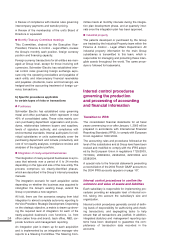APC 2004 Annual Report Download - page 36
Download and view the complete annual report
Please find page 36 of the 2004 APC annual report below. You can navigate through the pages in the report by either clicking on the pages listed below, or by using the keyword search tool below to find specific information within the annual report.
34
Review of compliance with internal rules governing
intercompany payments and transfer pricing.
Review of the membership of the unit's Board of
Directors or equivalent
Monthly Treasury Committee meetings
This Committee, chaired by the Executive Vice-
President, Finance & Control - Legal Affairs, reviews
the Group's monthly cash position, foreign currency
position and financing capacity.
Foreign currency transactions for all entities are man-
aged at Group level, except for those involving soft
currencies. Schneider Electric has established inter-
nal control rules governing foreign exchange expo-
sure-only the operating receivables and payables of
each entity and intercompany financial receivables
and payables (dividends, loans and borrowings) are
hedged-and the accounting treatment of foreign cur-
rency transactions.
b) Specific procedures applicable
to certain types of risks or transactions
Purchases
Schneider Electric has established rules governing
metal and other purchases, which represent in total
40% of consolidated sales. These rules mainly con-
cern purchasing department organization and proce-
dures, relationships between buyers and suppliers,
levels of signature authority, and compliance with
environmental standards. Internal audit plans for indi-
vidual subsidiaries or units systematically cover the
purchasing department and include productivity and
cost of non-quality analyses, compliance reviews and
analyses of the supplier portfolio.
Integration of newly-acquired businesses
The integration of newly-acquired businesses is a pro-
cess that extends over a period of 6 to 24 months
depending on the type and size of the new entity. The
process comprises six clearly-identified phases,
which are described in the Group's internal procedure
manuals.
The integration scenario for each acquisition varies
depending on whether the business was acquired to
strengthen the Group's existing lineup, extend the
lineup or penetrate a new segment.
All told, there are five scenarios ranging from total
integration to almost complete autonomy reporting to
the Vice President, Strategic Development. Depending
on the strategic objective, a matrix is drawn up show-
ing the required level of integration for each of the
newly-acquired business's core functions, i.e. front
office (sales force and brand), back office, R&D, cor-
porate functions and management reporting.
An integration plan is drawn up for each acquisition
and is implemented by an integration manager who
reports to a Steering Committee. The Steering Com-
mittee meets at monthly intervals during the integra-
tion plan development phase, and at quarterly inter-
vals once the integration plan has been approved.
Industrial property
The patents developed or purchased by the Group
are tracked by the Industrial Property team within the
Finance & Control - Legal Affairs Department. All
industrial property information for the main Group
subsidiaries is transmitted to this team, which is
responsible for managing and protecting these intan-
gible assets throughout the world. The same proce-
dure is followed for trademarks.
Internal control procedures
governing the production
and processing of accounting
and financial information
Transition to IFRS
The consolidated financial statements for all fiscal
years commencing on or after January 1, 2005 will be
prepared in accordance with International Financial
Reporting Standards (IFRS), to comply with European
Union regulation 1606/2002.
The accounting rules and procedures followed at the
level of the subsidiaries and at Group level have been
revised and modified to comply with the IFRS adopt-
ed by the European Union in regulations 1725/2003,
707/2004, 2086/2004, 2236/2004, 2237/2004 and
2238/2004.
A special note to the financial statements presenting
a reconciliation of the 2004 French GAAP accounts to
the 2004 IFRS accounts appears on page 107.
Internal control procedures to confirm the
existence and value of assets and liabilities
Each subsidiary is responsible for implementing pro-
cedures providing an adequate level of internal con-
trol, taking into account the subsidiary's size and
organization.
Internal control procedures generally consist of defin-
ing levels of responsibility for authorizing and check-
ing transactions, and segregating tasks to help
ensure that all transactions are justified. In addition,
integrated statutory and management reporting sys-
tems have been developed to guarantee the com-
pleteness of transaction data recorded in the
accounts.
























